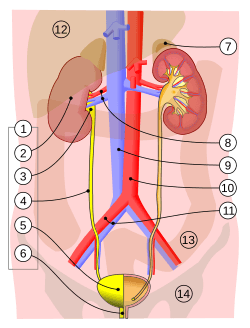Bladder facts for kids
Quick facts for kids Urinary bladder |
|
|---|---|
 |
|
| 1. Human urinary system: 2. Kidney, 3. Renal pelvis, 4. Ureter, 5. Urinary bladder, 6. Urethra. (Left side with frontal section) 7. Adrenal gland Vessels: 8. Renal artery and vein, 9. Inferior vena cava, 10. Abdominal aorta, 11. Common iliac artery and vein With transparency: 12. Liver, 13. Large intestine, 14. Pelvis |
|
| Latin | vesica urinaria |
| System | Urinary system |
| Precursor | urogenital sinus |
The urinary bladder, often just called the bladder, is a special hollow organ inside your body. It's found in humans and many other animals with backbones (called vertebrates). Its main job is to store urine that comes from your kidneys.
When your bladder is full, you feel the need to go to the bathroom. An adult human bladder can usually hold about 300 to 500 milliliters (about 1.5 to 2 cups) of urine before you feel the urge to empty it. However, it can hold even more if needed!
Contents
How the Bladder Works
Your kidneys make urine, which then travels to your bladder. The bladder holds this urine until you are ready to get rid of it. When you urinate (also called micturition), the urine leaves your bladder through a tube called the urethra. This tube carries the urine out of your body.
Urination is a teamwork effort involving your muscles and brain. A special muscle in your bladder, called the detrusor muscle, squeezes to push the urine out. This process is controlled by signals from your spine and brain.
You start to feel the need to urinate when your bladder has about 300 to 400 milliliters of urine. This feeling comes from tiny sensors in your bladder that detect when it stretches. A part of your brainstem helps control when you urinate.
Bladders in Other Animals
Not just humans have bladders! Many different animals have them, but they can be quite different.
Mammals
All mammals, like dogs, cats, and even whales, have a urinary bladder. The bladders of cetaceans (whales and dolphins) are smaller compared to their body size than those of mammals that live on land.
Reptiles
Many reptiles, such as turtles, tortoises, and most lizards, have bladders. However, some reptiles like snakes, alligators, and crocodiles do not have a bladder. Instead, their urine, poop, and eggs all leave through a single opening called a cloaca.
Some turtles and tortoises have very large bladders. For example, the Galapagos tortoise can store urine that weighs up to 20% of its body weight! This is a special adaptation for animals living in places where water is hard to find, like deserts or remote islands. These large bladders can store water for months and help the animals stay hydrated.
Turtles often have extra bladders next to their main one. These can hold even more water.
Amphibians
Most amphibians, like frogs and salamanders, can absorb water through their skin. Their bladders help them keep important salts in their bodies. If a land-dwelling amphibian starts to get dry, it will produce less urine to save water.
The bladder of an amphibian can stretch a lot. For some frogs and salamanders that live on land, their bladder can hold urine that makes up 20% to 50% of their total body weight!
Fish
Most fish have gills that help them get rid of waste like ammonia. Even though they live in water, most fish still have a bladder to store liquid waste.
It's important to know that most fish also have a "swim-bladder." This organ helps them float and control their depth in the water. It's not related to the urinary bladder, even though they both have "bladder" in their name. Some fish, like loaches and herrings, have a very small or poorly developed urinary bladder.
Birds
Almost all bird species do not have a urinary bladder. Birds have kidneys, but their ureters (tubes that carry urine from the kidneys) open directly into their cloaca. The cloaca acts as a storage area for urine, poop, and eggs.
Crustaceans
Crustaceans, like crabs and lobsters, have a urinary bladder that is different from ours. Their bladder not only stores urine but also changes it. It has different sections that spread out through their body cavity. The bladder tissue is very thin.
See also
 In Spanish: Vejiga urinaria para niños
In Spanish: Vejiga urinaria para niños

